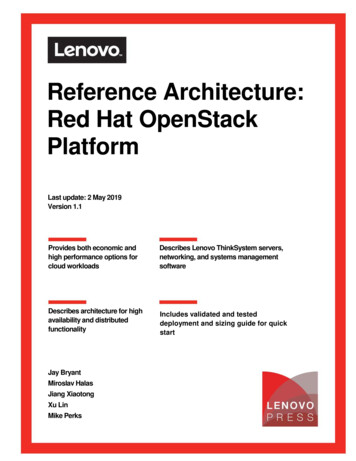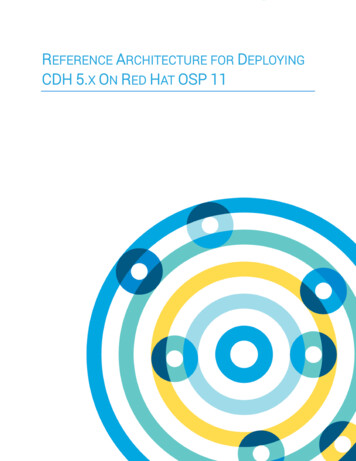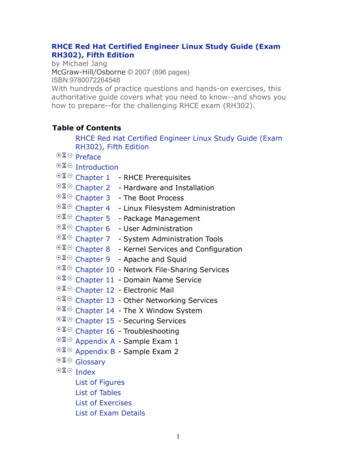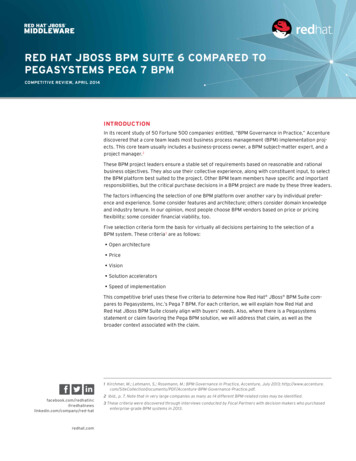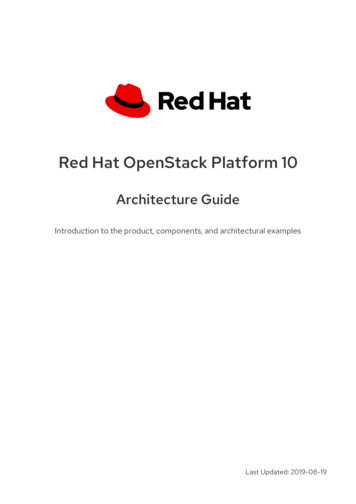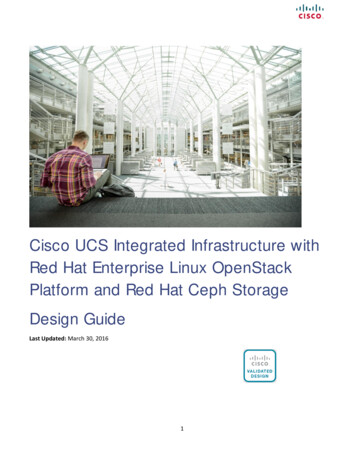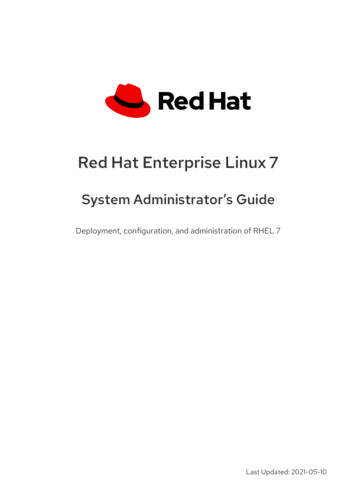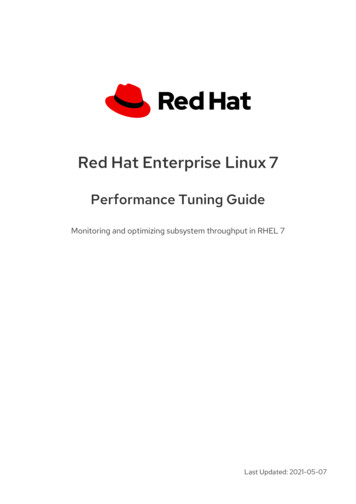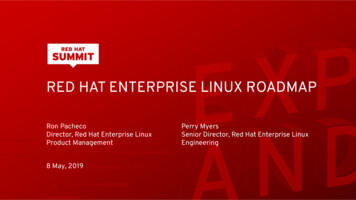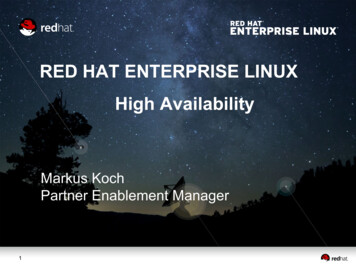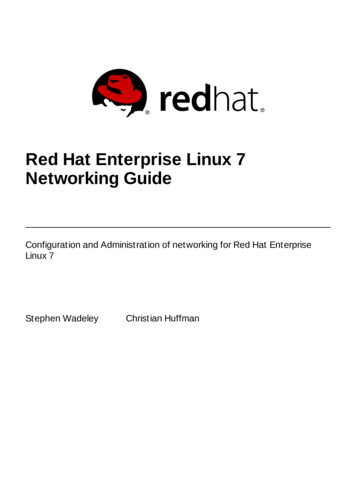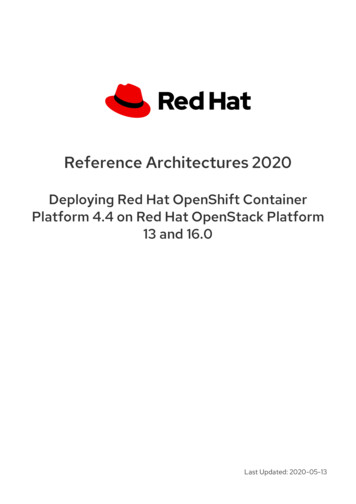
Transcription
Reference Architectures 2020Deploying Red Hat OpenShift ContainerPlatform 4.4 on Red Hat OpenStack Platform13 and 16.0Last Updated: 2020-05-13
Reference Architectures 2020 Deploying Red Hat OpenShift ContainerPlatform 4.4 on Red Hat OpenStack Platform 13 and 16.0August Simonelliasimonel@redhat.com
Legal NoticeCopyright 2020 Red Hat, Inc.The text of and illustrations in this document are licensed by Red Hat under a Creative CommonsAttribution–Share Alike 3.0 Unported license ("CC-BY-SA"). An explanation of CC-BY-SA isavailable athttp://creativecommons.org/licenses/by-sa/3.0/. In accordance with CC-BY-SA, if you distribute this document or an adaptation of it, you mustprovide the URL for the original version.Red Hat, as the licensor of this document, waives the right to enforce, and agrees not to assert,Section 4d of CC-BY-SA to the fullest extent permitted by applicable law.Red Hat, Red Hat Enterprise Linux, the Shadowman logo, the Red Hat logo, JBoss, OpenShift,Fedora, the Infinity logo, and RHCE are trademarks of Red Hat, Inc., registered in the United Statesand other countries.Linux is the registered trademark of Linus Torvalds in the United States and other countries.Java is a registered trademark of Oracle and/or its affiliates.XFS is a trademark of Silicon Graphics International Corp. or its subsidiaries in the United Statesand/or other countries.MySQL is a registered trademark of MySQL AB in the United States, the European Union andother countries.Node.js is an official trademark of Joyent. Red Hat is not formally related to or endorsed by theofficial Joyent Node.js open source or commercial project.The OpenStack Word Mark and OpenStack logo are either registered trademarks/service marksor trademarks/service marks of the OpenStack Foundation, in the United States and othercountries and are used with the OpenStack Foundation's permission. We are not affiliated with,endorsed or sponsored by the OpenStack Foundation, or the OpenStack community.All other trademarks are the property of their respective owners.AbstractThe purpose of this document is to provide guidelines and considerations for deploying Red HatOpenShift Container Platform 4.4 on Red Hat OpenStack Platform 13 and 16.0.
Table of ContentsTable of Contents. . . . . . .I. EXECUTIVEPART. . . . . . . . . . . . .SUMMARY. . . . . . . . . . . . . . . . . . . . . . . . . . . . . . . . . . . . . . . . . . . . . . . . . . . . . . . . . . . . . . . . . . . . . . . . . . . . . . . . . . . . . . . .4. . . . . . . . . . . . . . . . . . . . . . . 1. .ABOUTCHAPTER. . . . . . . .THIS. . . . . DOCUMENT. . . . . . . . . . . . . . . . . . . . . . . . . . . . . . . . . . . . . . . . . . . . . . . . . . . . . . . . . . . . . . . . . . . . . . . . . . . . . . . . . . . 5. . . . . . . . . . . . .CHAPTER. . . . . . . . . . 2. . SOLUTION. . . . . . . . . . . . OVERVIEW. . . . . . . . . . . . . . . . . . . . . . . . . . . . . . . . . . . . . . . . . . . . . . . . . . . . . . . . . . . . . . . . . . . . . . . . . . . . . . . . . . . . 6. . . . . . . . . . . . .2.1. TARGET USE CASES62.2. SOLUTION BENEFITS FOR IT AND BUSINESS6.CHAPTER. . . . . . . . . . 3. . ARCHITECTURE. . . . . . . . . . . . . . . . . .OVERVIEW. . . . . . . . . . . . . . . . . . . . . . . . . . . . . . . . . . . . . . . . . . . . . . . . . . . . . . . . . . . . . . . . . . . . . . . . . . . . . . 7. . . . . . . . . . . . .3.1. INSTALLING RED HAT OPENSTACK PLATFORM73.2. INSTALLING RED HAT OPENSHIFT CONTAINER PLATFORM 4.X73.3. RELATIONSHIP BETWEEN RED HAT OPENSHIFT CONTAINER PLATFORM AND RED HAT OPENSTACKPLATFORM83.3.1. Introducing Red Hat Enterprise Linux (RHEL) CoreOS83.3.1.1. Ignition3.4. REFERENCE ARCHITECTURE HIGH LEVEL DESIGN89. . . . . . . . . . . 4.CHAPTER. . .DESIGN. . . . . . . . CONSIDERATIONS. . . . . . . . . . . . . . . . . . . . . . . . . . . . . . . . . . . . . . . . . . . . . . . . . . . . . . . . . . . . . . . . . . . . . . . . . . . . . . . . . . . . . . 12.4.1. CONNECTIVITY IMPLEMENTATION4.1.1. Deploying RHOCP with a direct Internet connection4.1.2. Deploying RHOCP using a corporate proxy service1212124.1.3. Deploying RHOCP in a restricted network environment4.2. INSTALLATION METHODS AND TOOLING12124.2.1. Red Hat OpenStack Platform director4.2.2. Red Hat OpenShift Container Platform installation program4.2.2.1. Installer-provisioned infrastructure4.2.2.2. Generating the installation configuration file131314144.3. IMPLEMENTING HIGH AVAILABILITY4.3.1. RHOSP HA4.3.2. RHOCP HA1416164.3.3. Storage HA4.3.4. Hardware HA4.4. STORAGE1617174.4.1. Red Hat Ceph Storage4.4.2. Red Hat Ceph Storage backends4.4.3. Persistent volumes for RHOCP4.4.4. Object storage171718184.4.4.1. RHOSP registry and object storage4.4.5. Image storage4.5. NETWORKING4.5.1. OpenStack Networking (neutron)4.5.2. Networking in Red Hat OpenShift Container Platform19191919204.5.2.1. OpenShift SDN4.5.2.2. Kuryr4.6. DNS4.6.1. DNS setup202121224.6.1.1. OpenShift API DNS4.6.1.2. Application DNS4.6.1.3. Bootstrap node4.7. SECURITY AND AUTHENTICATION4.7.1. Authentication22222323234.7.2. Security241
Reference Architectures 2020 Deploying Red Hat OpenShift Container Platform 4.4 on Red Hat OpenStack Platform 13 and4.7.2.1. RHOSP security4.7.2.2. RHOCP security2424.CHAPTER. . . . . . . . . . 5. . RESOURCE. . . . . . . . . . . . .CONSIDERATIONS. . . . . . . . . . . . . . . . . . . .AND. . . . .LIMITATIONS. . . . . . . . . . . . . . . . . . . . . . . . . . . . . . . . . . . . . . . . . . . . . . . . . . . . . . . . .25.5.1. DISK255.1.1. Minimum disk requirements for etcd255.1.2. Providing disk to RHOCP nodes5.1.2.1. Ephemeral on Compute nodes5.1.2.2. Ceph-backed ephemeral5.1.2.3. Volumes provided by Red Hat OpenStack Block Storage5.2. LIMITATIONS5.2.1. Internal TLS (TLS Everywhere) with Red Hat Identity Management5.2.2. RHOCP installer-provisioned infrastructure subnets5.2.3. ReadWriteMany (RWX) PersistentVolumes (PVs)5.2.4. Red Hat OpenShift Container Storage 4252525262728282829. . . . . . . . . . . 6.CHAPTER. . .REFERENCE. . . . . . . . . . . . .ARCHITECTURE. . . . . . . . . . . . . . . . .IMPLEMENTATION. . . . . . . . . . . . . . . . . . . . . . . . . . . . . . . . . . . . . . . . . . . . . . . . . . . . . . . . . . . . . . . .30.6.1. RED HAT OPENSTACK PLATFORM INSTALLATION6.1.1. RHOSP deployment6.1.2. Preparing the environment3030326.1.2.1. RHOSP administration6.2. RHOCP TENANT OPERATIONS32346.3. RED HAT OPENSHIFT CONTAINER PLATFORM INSTALLATION366.4. RED HAT OPENSHIFT CONTAINER PLATFORM ON RED HAT OPENSTACK PLATFORM DEPLOYMENT6.5. POST INSTALLATION40436.5.1. Make the ingress floating IP available6.5.2. Place master nodes on separate Compute nodes43446.5.3. Verify the cluster status44. . . . . . . . . . . 7.CHAPTER. . SUMMARY. . . . . . . . . . . . . . . . . . . . . . . . . . . . . . . . . . . . . . . . . . . . . . . . . . . . . . . . . . . . . . . . . . . . . . . . . . . . . . . . . . . . . . . . . . . . . . .46. . . . . . . . . . . 8.CHAPTER. . .REFERENCES. . . . . . . . . . . . . . . . . . . . . . . . . . . . . . . . . . . . . . . . . . . . . . . . . . . . . . . . . . . . . . . . . . . . . . . . . . . . . . . . . . . . . . . . . . . . . .47. . . . . . . . . . . 9.CHAPTER. . .CONTRIBUTORS. . . . . . . . . . . . . . . . . . . . . . . . . . . . . . . . . . . . . . . . . . . . . . . . . . . . . . . . . . . . . . . . . . . . . . . . . . . . . . . . . . . . . . . . . . . . . .49.2
Table of Contents3
Reference Architectures 2020 Deploying Red Hat OpenShift Container Platform 4.4 on Red Hat OpenStack Platform 13 andPART I. EXECUTIVE SUMMARYOrganizations across the globe continue to rapidly develop innovative software applications in hybridand multi-cloud environments in order to achieve competitive advantages and ensure customersatisfaction. Many of these applications are deployed in a private cloud due to security and compliance,data affinity, and performance requirements. The IT organizations responsible for operating the privatecloud value simplicity, agility, flexibility, security, and cost efficiency, as these features reduce their ownbarriers to innovation as part of their overall hybrid and multi-cloud strategy.This reference architecture showcases a prescriptive, pre-validated, private cloud solution from Red Hatthat provides IT as a Service (ITaaS), and the rapid provisioning and lifecycle management ofcontainerized apps, virtual machines (VMs), and associated application and infrastructure services forcloud users such as software developers, data scientists, and solution architects. Red Hat OpenShiftContainer Platform, Red Hat OpenStack Platform, and Red Hat Ceph Storage are the key architecturecomponents of this solution.This reference architecture updates Deploying Red Hat OpenShift Container Platform 3.11 on Red HatOpenStack Platform 13 for the Red Hat OpenShift Container Platform 4.x stream. If you want toimplement Red Hat OpenShift Container Platform 3.11, or are working with existing Red Hat OpenShiftContainer Platform 3.11 installs, then use the reference architecture for Red Hat OpenShift ContainerPlatform 3.11, as there are significant differences in the 4.x release stream.4
CHAPTER 1. ABOUT THIS DOCUMENTCHAPTER 1. ABOUT THIS DOCUMENTThis document provides an overview of the options available for implementing Red Hat OpenShiftContainer Platform (RHOCP) on Red Hat OpenStack Platform (RHOSP), and reviews how weimplement those solutions to deploy the reference architecture within a lab-based environment.This document is not an implementation guide. Complete, supported, and fully tested documentationexists for all the components included within this reference architecture, including:Red Hat OpenStack Platform 13Red Hat OpenStack Platform 16.0Red Hat OpenShift Platform 4.4Red Hat Ceph Storage 3Red Hat Ceph Storage 45
Reference Architectures 2020 Deploying Red Hat OpenShift Container Platform 4.4 on Red Hat OpenStack Platform 13 andCHAPTER 2. SOLUTION OVERVIEW2.1. TARGET USE CASESThis reference architecture is valuable for enterprise, telecommunications, government, and IT serviceprovider organizations that want to deploy a private cloud solution with programmable Infrastructure asa Service (IaaS), Containers as a Service (CaaS), and Platform as a Service (PaaS) capabilities.2.2. SOLUTION BENEFITS FOR IT AND BUSINESSThe key benefits and value of this solution for IT organizations and the business are as follows:Faster innovation and time-to-value: The reference architecture saves the organization timeas it supplements the design, deploy, and test of a full solution stack composed of several RedHat products.Simpler and safer deployments: All the desired best practices for the full solution stack arealready pre-validated by Red Hat, resulting in a highly prescriptive solution to ensure success.Cost efficient: The reference architecture is based on open source technologies that are fullysupported by Red Hat.6
CHAPTER 3. ARCHITECTURE OVERVIEWCHAPTER 3. ARCHITECTURE OVERVIEWThis is a reference architecture for running Red Hat OpenShift Container Platform 4.4 on Red HatOpenStack Platform 13 or Red Hat OpenStack Platform 16.0.3.1. INSTALLING RED HAT OPENSTACK PLATFORMRed Hat OpenStack Platform (RHOSP) is deployed to physical servers using the RHOSP director.Director is a toolset for installing and managing a complete RHOSP environment from installation toDay 2 operations.3.2. INSTALLING RED HAT OPENSHIFT CONTAINER PLATFORM 4.XRed Hat OpenShift Container Platform (RHOCP) has a new installation program for the 4.x stream. Itfeatures a streamlined interface and simplified installation process allowing a faster, easier, and moreprecise installation. For more information, see the Red Hat OpenShift Container Platform 4.4 Installingguide.The RHOCP 4 installation program offers the following types of deployment:Installer-provisioned infrastructure clusters: The RHOCP 4 installation program manages allaspects of the installation, including infrastructure provisioning, with a RHOCP best practicedeployment.User-provisioned infrastructure clusters: Administrators are responsible for preparing,creating and managing their own underlying infrastructure for clusters. This approach allowsgreater customization prior to installing RHOCP.Both types of clusters have the following characteristics:Highly available infrastructure with no single points of failure by default.A deep integration between RHOCP and the underlying operating system, Red Hat EnterpriseLinux CoreOS (RHCOS), that provides “appliance-like” integration.Administrators maintain control over what updates are applied, and when.This reference architecture features the installer-provisioned infrastructure method for installingRHOCP onto RHOSP. Following this method, the installation program creates all the networking,machines, and operating systems required when using the OpenStack APIs. This results in anarchitecture that is highly available, fully tested, and entirely supported, suitable for production today.NOTE7
Reference Architectures 2020 Deploying Red Hat OpenShift Container Platform 4.4 on Red Hat OpenStack Platform 13 andNOTEThe new installer-provisioned infrastructure method for RHOCP is highlyprescriptive, as it installs a “best practice” deployment. The infrastructure of aninstaller-provisioned infrastructure deployment should not be customised afterdeployment. Any infrastructure changes must be implemented by the installationprogram, which interacts directly with the underlying infrastructure and APIs.Only Day 2 infrastructure operations, such as machine scale outs, arerecommended.For enterprises that need additional infrastructure customisations andrequirements, the simplicity of the installer-provisioned infrastructure methodmay be limiting. In this case, the user-provisioned infrastructure method may bemore appropriate.This document describes a reference
13.05.2020 · REFERENCE ARCHITECTURE HIGH LEVEL DESIGN C A T R D SG C N I E A I NS 4.1. CONNECTIVITY IMPLEMENTATION 4.1.1. Deploying RHOCP with a direct Internet connection 4.1.2. Deploying RHOCP using a corporate proxy service 4.1.3. Deploying RHOCP in a restricted network environment 4.2. INSTALLATION METHODS AND TOOLING 4.2.1. Red Hat OpenStack Platform
